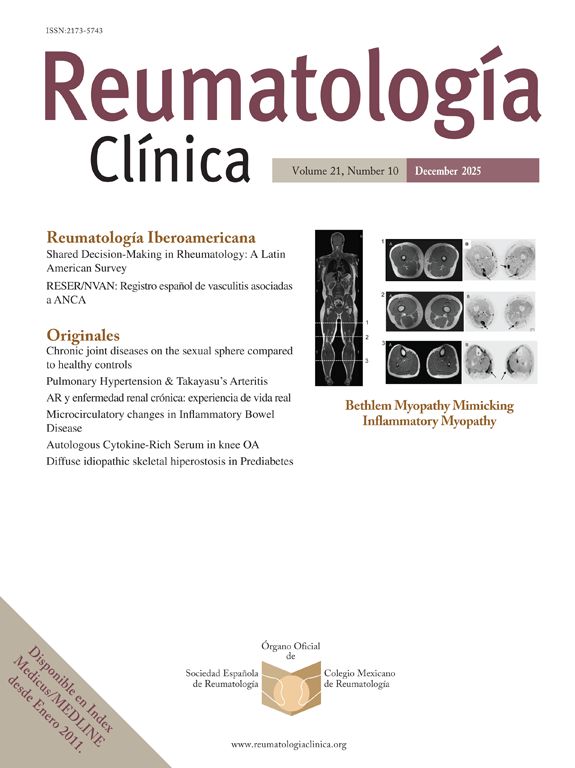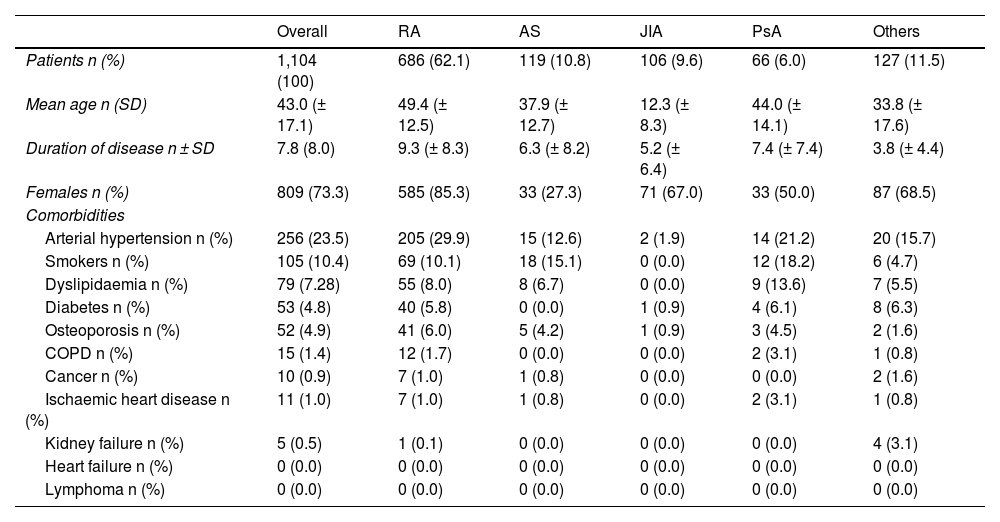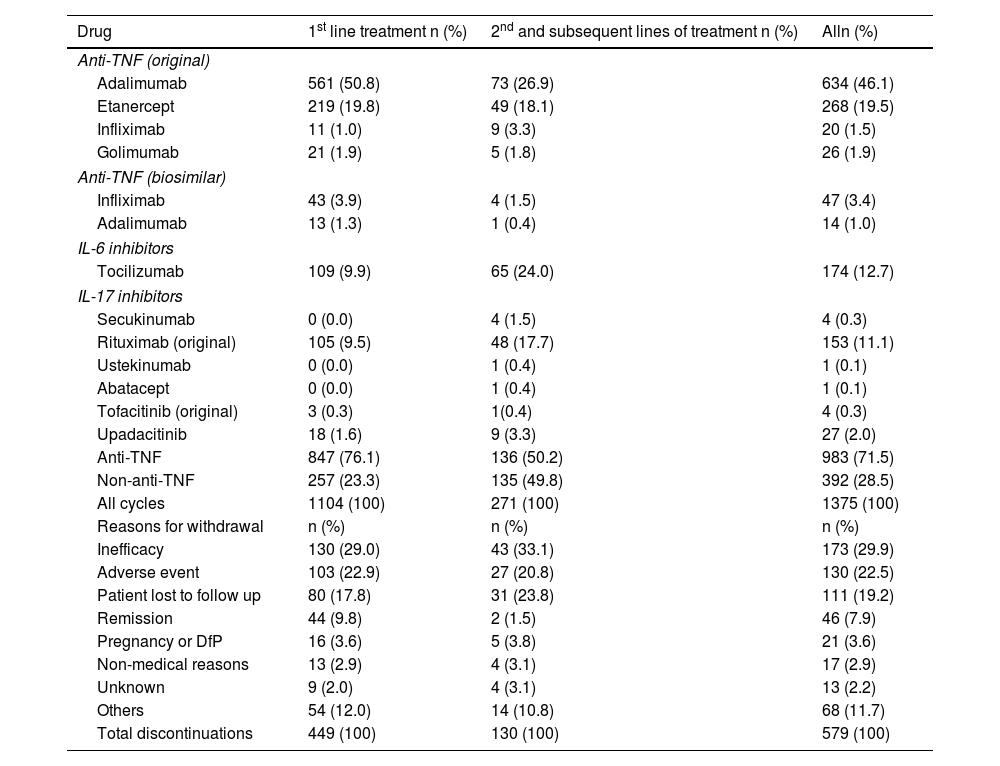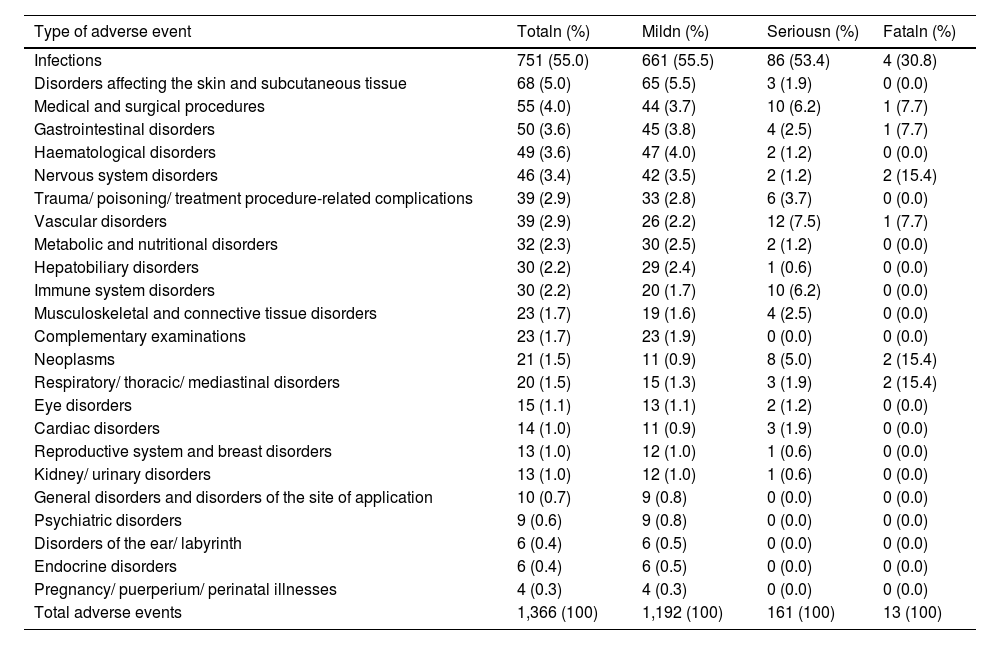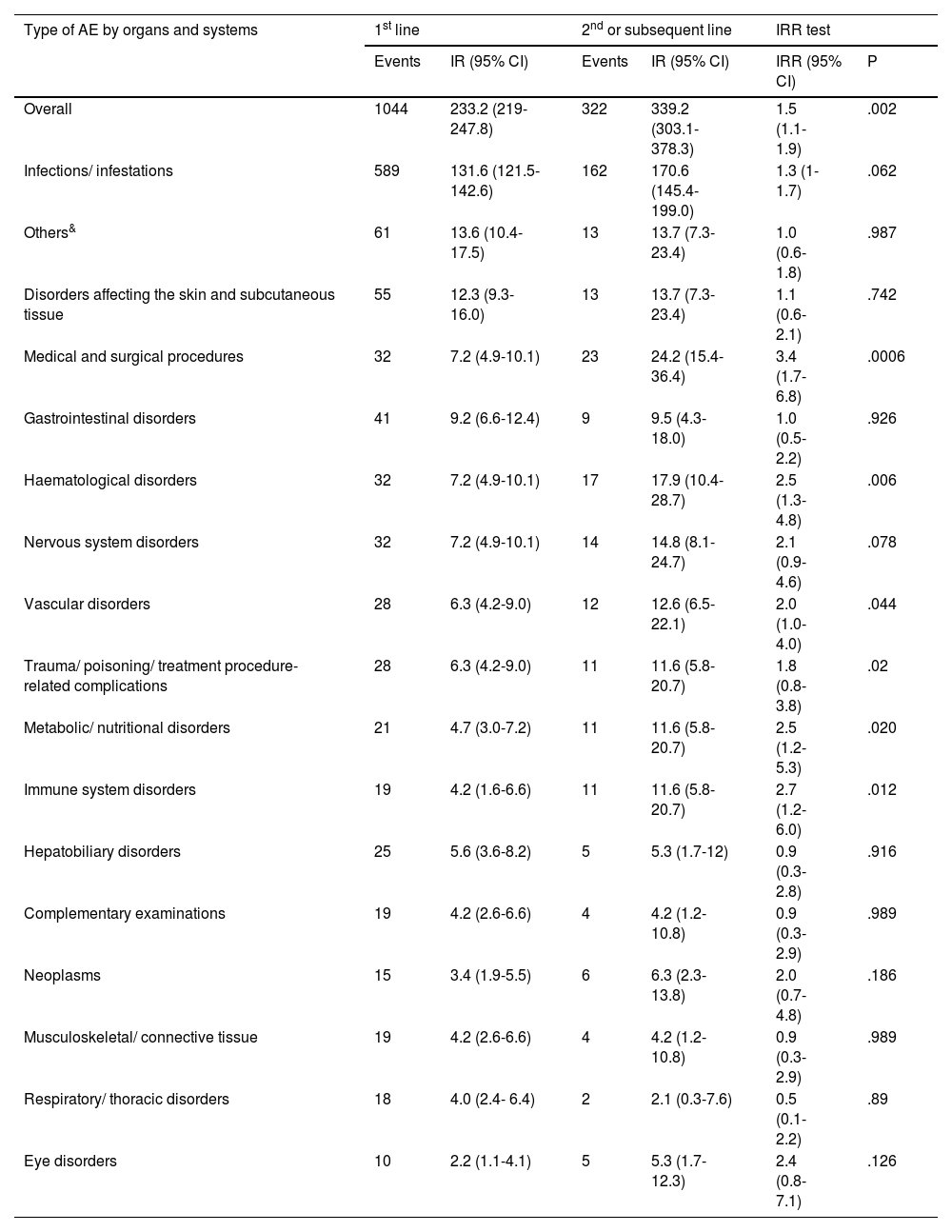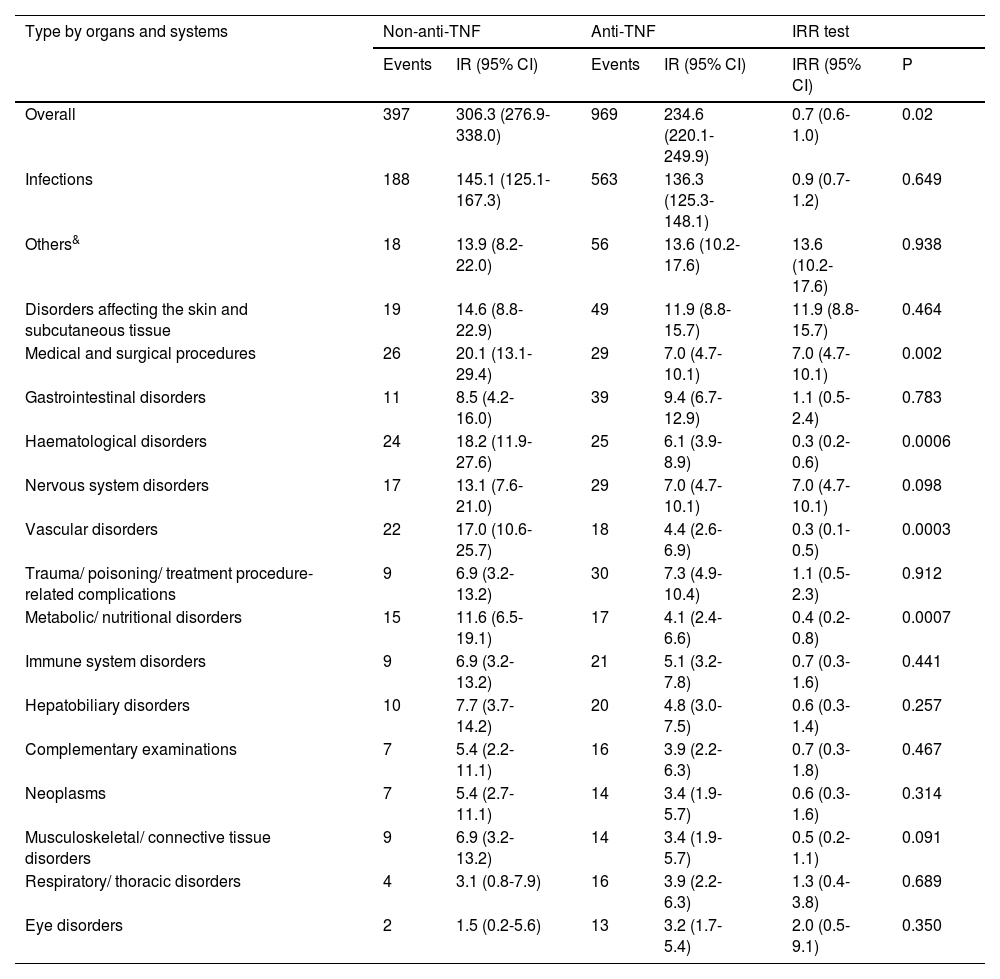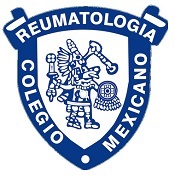To analyze the safety of biologic (DMARDs-b) and synthetic targeted therapies (DMARDs-sd) in the BIOBADAGUAY registry (Paraguayan-Uruguayan registry of adverse events (AEs) in patients with inflammatory rheumatic diseases).
MethodsBIOBADAGUAY is a registry to prospectively evaluate the efficacy and safety of FAME-b and FAME-sd. The full methodology is available at https://biobadaguay.ser.es. Variables associated with the safety of the therapies were used for the present study. The incidence of AA was calculated as incidence rate (IR) per 1000 patient-years, with 95% confidence intervals (CI) and Poisson regression for the incidence rate ratio (IRR).
Results1104 patients (73.3% female) with 1366 AA, predominantly mild (87.2%), were analyzed. The overall incidence of AEs was 251.75 per 1000 patient-years. Infections were the most frequent (55.0%), with an incidence of 138.4 per 1000 patient-years. Rheumatoid arthritis and corticosteroid use were associated with more global AEs, while anti-TNF was associated with less AEs.
ConclusionsThis study from the BIOBADAGUAY registry has provided valuable data on the safety of DMARD-b, sd in a cohort of patients with inflammatory rheumatic diseases. The incidence of predominantly mild AEs, with infections as the most frequent adverse event, underscores the need for rigorous and constant monitoring in this population.
Analizar la seguridad de las terapias biológicas (FAME-b) y sintéticas dirigidas (FAME-sd) en el registro BIOBADAGUAY (registro paraguayo-uruguayo de acontecimientos adversos (AA) en pacientes con enfermedades reumáticas inflamatorias).
MétodoBIOBADAGUAY es un registro para evaluar prospectivamente la eficacia y seguridad de los FAME-b y FAME-sd. La metodología completa está disponible en https://biobadaguay.ser.es. Para el presente estudio se utilizaron variables asociadas a la seguridad de las terapias. La incidencia de AA se calculó como tasa de incidencia (IR) por 1000 pacientes-año, con intervalos de confianza (IC) del 95% y la regresión de Poisson para la razón de tasa de incidencia (IRR).
ResultadosSe analizaron 1104 pacientes (73,3% mujeres) con 1366 AA, predominantemente leves (87,2%). La incidencia global de AA fue de 251,75 por 1000 pacientes-año. Las infecciones fueron las más frecuentes (55,0%), con una incidencia de 138,4 por 1000 pacientes-año. La artritis reumatoide y el uso de corticoides se asociaron con más AA globales, mientras que los anti-TNF se asociaron con menos AA.
ConclusionesEste estudio del registro BIOBADAGUAY ha proporcionado datos valiosos sobre la seguridad de los FAME-b, sd en una cohorte de pacientes con enfermedades reumáticas inflamatorias. La incidencia de AA, predominantemente leves y con las infecciones como el evento adverso más frecuente, subraya la necesidad de mantener un monitoreo riguroso y constante en esta población.
Better understanding of the pathophysiology of the inflammatory process, earlier diagnosis, implementation of treatment under specific and strict targets, aiming for remission or otherwise minimal disease activity, as well as the development of new drugs have improved patient outcomes and prognosis.1,2 With the introduction of tumour necrosis factor alpha (TNF) inhibitors in the late 1990s, there has been an increase in other classes of disease-modifying biologic drugs (bDMARDs), and, in more recent times, synthetic small molecules with identifiable targets (tsDMARDs).3
Numerous randomised and controlled clinical trials have proven the efficacy and safety of these agents4; nevertheless, these results may not always lend themselves to evaluation due to their strict inclusion and exclusion criteria and limited follow-up periods. Therefore, assessments in real-life settings have been regarded as necessary if we are to establish the efficacy and safety of this class of drugs in clinical practice5; in pursuit of this aim, a number of b- and tsDMARD registries have been set up in different countries.6–8 In our setting, the socioeconomic, genetic, demographic, and epidemiological reality differs from that of other countries, which could have a bearing on treatment response and the presentation of certain adverse events (AEs). Consequently, the Paraguayan Society of Rheumatology (SPR, its acronym in Spanish) and the Uruguayan Society of Rheumatology promoted the Paraguayan Uruguayan registry of AEs in patients with inflammatory rheumatic diseases treated with bDMARDS and tsDMARDs (BIOBADAGUAY). The objective of this study is to analyse the safety of b- and tsDMARDs in the BIOBADAGUAY registry.
Study designThis is a prospective study of the BIOBADAGUAY 2.0 registry. This registry, which covers two Latin American countries, was launched in 2016 and its methodology has been outlined in earlier articles.6 Although the registry includes patients from Paraguay and Uruguay on the same platform, each country participates independently, with a common coordinator for both countries. Recruitment is a dynamic process, with subjects being enrolled when they initiate the target treatment and remains open indefinitely. The database is monitored online under the coordinator's supervision. More information on the methodology is available on the registry website (https://biobadaguay.ser.es).
PatientsAll patients recorded in the registry from July 2016 to October 2022 were incorporated into the analysis. Both adult and paediatric subjects were included so as to determine overall rates of AEs.
VariablesThe clinical and epidemiological variables of the registry were examined. The type of AE, the outcome, and its severity were entered. An event was categorised as serious if it resulted in death, was life-threatening, required or prolonged hospitalisation, or resulted in persistent or significant disability or congenital malformations. The Medical Dictionary for Drug Regulatory Activities (MedDRA) nomenclature was used to classify each of the AEs (www.meddra.org).
Statistical analysisFor the descriptive analysis, epidemiological variables, clinical variables, and the therapies administered were examined. The means were evaluated for continuous variables with their corresponding standard deviation (SD) and the categorical variables were assessed with their frequency and percentage. In order to calculate the incidence of AEs, we used Poisson regression to compute the incidence rate (IR) per 1,000 patient-years, 95% confidence interval (CI), and the incidence rate ratio (IRR).
ResultsThis study has probed the data from 22 centres that participate in the BIOBADAGUAY registry: 11 in Paraguay and 11 in Uruguay.
Clinical characteristics of the patients and treatmentA total of 1,104 subjects who received b- and stDMART were registered; 809 (73.3%) were female, with a mean age at age at the time when they first started treatment of 43.0 ± 17.1 years and a mean duration of disease at the initiation of their first treatment of 7.8 ± 8.0 years. The most common diagnosis was rheumatoid arthritis (RA) 686 (62.1%). The most relevant characteristics of the population included in the registry are depicted in Table 1. A total of 1,375 treatments were administered. The drugs most widely used as first-line treatment (first b- and tsDMARD) were the original adalimumab (50.8%) and the original etanercept (19.8%). In the context of second and subsequent lines (second or subsequent bDMARD and tsDMARD administered) of treatment, the original adalimumab (26.9%) and tocilizumab (24%) were the most frequent. Methotrexate was the concomitant treatment most often recorded in both the first line of treatment (68.1%) and second and subsequent lines (59%). Glucocorticoids were used in 51.3% of all treatments. A description of the treatment lines is provided in Table 2. There were 579 discontinuations, with inefficacy and/or loss of efficacy (29.9%) most often prompting treatment withdrawal. Table 2 outlines the various causes for suspending treatment.
Patient characteristics at treatment initiation.
| Overall | RA | AS | JIA | PsA | Others | |
|---|---|---|---|---|---|---|
| Patients n (%) | 1,104 (100) | 686 (62.1) | 119 (10.8) | 106 (9.6) | 66 (6.0) | 127 (11.5) |
| Mean age n (SD) | 43.0 (± 17.1) | 49.4 (± 12.5) | 37.9 (± 12.7) | 12.3 (± 8.3) | 44.0 (± 14.1) | 33.8 (± 17.6) |
| Duration of disease n ± SD | 7.8 (8.0) | 9.3 (± 8.3) | 6.3 (± 8.2) | 5.2 (± 6.4) | 7.4 (± 7.4) | 3.8 (± 4.4) |
| Females n (%) | 809 (73.3) | 585 (85.3) | 33 (27.3) | 71 (67.0) | 33 (50.0) | 87 (68.5) |
| Comorbidities | ||||||
| Arterial hypertension n (%) | 256 (23.5) | 205 (29.9) | 15 (12.6) | 2 (1.9) | 14 (21.2) | 20 (15.7) |
| Smokers n (%) | 105 (10.4) | 69 (10.1) | 18 (15.1) | 0 (0.0) | 12 (18.2) | 6 (4.7) |
| Dyslipidaemia n (%) | 79 (7.28) | 55 (8.0) | 8 (6.7) | 0 (0.0) | 9 (13.6) | 7 (5.5) |
| Diabetes n (%) | 53 (4.8) | 40 (5.8) | 0 (0.0) | 1 (0.9) | 4 (6.1) | 8 (6.3) |
| Osteoporosis n (%) | 52 (4.9) | 41 (6.0) | 5 (4.2) | 1 (0.9) | 3 (4.5) | 2 (1.6) |
| COPD n (%) | 15 (1.4) | 12 (1.7) | 0 (0.0) | 0 (0.0) | 2 (3.1) | 1 (0.8) |
| Cancer n (%) | 10 (0.9) | 7 (1.0) | 1 (0.8) | 0 (0.0) | 0 (0.0) | 2 (1.6) |
| Ischaemic heart disease n (%) | 11 (1.0) | 7 (1.0) | 1 (0.8) | 0 (0.0) | 2 (3.1) | 1 (0.8) |
| Kidney failure n (%) | 5 (0.5) | 1 (0.1) | 0 (0.0) | 0 (0.0) | 0 (0.0) | 4 (3.1) |
| Heart failure n (%) | 0 (0.0) | 0 (0.0) | 0 (0.0) | 0 (0.0) | 0 (0.0) | 0 (0.0) |
| Lymphoma n (%) | 0 (0.0) | 0 (0.0) | 0 (0.0) | 0 (0.0) | 0 (0.0) | 0 (0.0) |
SD: standard deviation (years); RA: rheumatoid arthritis; AS: ankylosing spondylitis; JIA: juvenile idiopathic arthritis; PsA: psoriatic arthritis; COPD: chronic obstructive pulmonary disease; Others: diagnoses with values of < 5% of the total.
Description of therapies and reasons for discontinuation.
| Drug | 1st line treatment n (%) | 2nd and subsequent lines of treatment n (%) | Alln (%) |
|---|---|---|---|
| Anti-TNF (original) | |||
| Adalimumab | 561 (50.8) | 73 (26.9) | 634 (46.1) |
| Etanercept | 219 (19.8) | 49 (18.1) | 268 (19.5) |
| Infliximab | 11 (1.0) | 9 (3.3) | 20 (1.5) |
| Golimumab | 21 (1.9) | 5 (1.8) | 26 (1.9) |
| Anti-TNF (biosimilar) | |||
| Infliximab | 43 (3.9) | 4 (1.5) | 47 (3.4) |
| Adalimumab | 13 (1.3) | 1 (0.4) | 14 (1.0) |
| IL-6 inhibitors | |||
| Tocilizumab | 109 (9.9) | 65 (24.0) | 174 (12.7) |
| IL-17 inhibitors | |||
| Secukinumab | 0 (0.0) | 4 (1.5) | 4 (0.3) |
| Rituximab (original) | 105 (9.5) | 48 (17.7) | 153 (11.1) |
| Ustekinumab | 0 (0.0) | 1 (0.4) | 1 (0.1) |
| Abatacept | 0 (0.0) | 1 (0.4) | 1 (0.1) |
| Tofacitinib (original) | 3 (0.3) | 1(0.4) | 4 (0.3) |
| Upadacitinib | 18 (1.6) | 9 (3.3) | 27 (2.0) |
| Anti-TNF | 847 (76.1) | 136 (50.2) | 983 (71.5) |
| Non-anti-TNF | 257 (23.3) | 135 (49.8) | 392 (28.5) |
| All cycles | 1104 (100) | 271 (100) | 1375 (100) |
| Reasons for withdrawal | n (%) | n (%) | n (%) |
| Inefficacy | 130 (29.0) | 43 (33.1) | 173 (29.9) |
| Adverse event | 103 (22.9) | 27 (20.8) | 130 (22.5) |
| Patient lost to follow up | 80 (17.8) | 31 (23.8) | 111 (19.2) |
| Remission | 44 (9.8) | 2 (1.5) | 46 (7.9) |
| Pregnancy or DfP | 16 (3.6) | 5 (3.8) | 21 (3.6) |
| Non-medical reasons | 13 (2.9) | 4 (3.1) | 17 (2.9) |
| Unknown | 9 (2.0) | 4 (3.1) | 13 (2.2) |
| Others | 54 (12.0) | 14 (10.8) | 68 (11.7) |
| Total discontinuations | 449 (100) | 130 (100) | 579 (100) |
Anti-TNF: anti-factor de necrosis tumoral; DfP: desire for pregnancy; Others: loss of medical insurance 39 (57.4%), change of healthcare centre 12 (17.6%), patient’s decision 8 (11.8%), and surgical procedure 8 (13.2%).
There were 1,366 AEs reported; 1,192 (87.3%) were mild; 161 (11.8%) were severe, and 13 (1.0%) were fatal. Table 3 illustrates both the frequency and percentage of AEs. Overall, the most prevalent AEs were infectious processes, 751 (55.0%), of which 661 (88.0%) were mild, 86 (11.5%) were severe, and four (0.5%) were fatal. Respiratory infection was the most common of all infections 339 (45.1%); of them, 303 (89.4%) were mild, 34 (10.0%) were severe, and two (0.6%) were fatal. Among the severe infectious AEs, there were 12 cases of tuberculosis, six of which were severe, and all the individuals affected recovered without sequelae. Anti-tumour necrosis factor (anti-TNF) therapy was most frequently associated with tuberculosis in 66.6% of cases. Fifteen malignant neoplasms were noted, the most recurrent of which was breast cancer (26.7%), followed by non-melanoma skin cancer (13.3%). Thirteen deaths were recorded (two cases of sepsis, two of pneumonia, two of pulmonary fibrosis, one metastatic gastrointestinal cancer, one acute lymphocytic leukaemia, two strokes, one acute myocardial infarction, one peritonitis, and one cardiac surgery).
Description of adverse events with biologic and synthetic targeted DMARDs.
| Type of adverse event | Totaln (%) | Mildn (%) | Seriousn (%) | Fataln (%) |
|---|---|---|---|---|
| Infections | 751 (55.0) | 661 (55.5) | 86 (53.4) | 4 (30.8) |
| Disorders affecting the skin and subcutaneous tissue | 68 (5.0) | 65 (5.5) | 3 (1.9) | 0 (0.0) |
| Medical and surgical procedures | 55 (4.0) | 44 (3.7) | 10 (6.2) | 1 (7.7) |
| Gastrointestinal disorders | 50 (3.6) | 45 (3.8) | 4 (2.5) | 1 (7.7) |
| Haematological disorders | 49 (3.6) | 47 (4.0) | 2 (1.2) | 0 (0.0) |
| Nervous system disorders | 46 (3.4) | 42 (3.5) | 2 (1.2) | 2 (15.4) |
| Trauma/ poisoning/ treatment procedure-related complications | 39 (2.9) | 33 (2.8) | 6 (3.7) | 0 (0.0) |
| Vascular disorders | 39 (2.9) | 26 (2.2) | 12 (7.5) | 1 (7.7) |
| Metabolic and nutritional disorders | 32 (2.3) | 30 (2.5) | 2 (1.2) | 0 (0.0) |
| Hepatobiliary disorders | 30 (2.2) | 29 (2.4) | 1 (0.6) | 0 (0.0) |
| Immune system disorders | 30 (2.2) | 20 (1.7) | 10 (6.2) | 0 (0.0) |
| Musculoskeletal and connective tissue disorders | 23 (1.7) | 19 (1.6) | 4 (2.5) | 0 (0.0) |
| Complementary examinations | 23 (1.7) | 23 (1.9) | 0 (0.0) | 0 (0.0) |
| Neoplasms | 21 (1.5) | 11 (0.9) | 8 (5.0) | 2 (15.4) |
| Respiratory/ thoracic/ mediastinal disorders | 20 (1.5) | 15 (1.3) | 3 (1.9) | 2 (15.4) |
| Eye disorders | 15 (1.1) | 13 (1.1) | 2 (1.2) | 0 (0.0) |
| Cardiac disorders | 14 (1.0) | 11 (0.9) | 3 (1.9) | 0 (0.0) |
| Reproductive system and breast disorders | 13 (1.0) | 12 (1.0) | 1 (0.6) | 0 (0.0) |
| Kidney/ urinary disorders | 13 (1.0) | 12 (1.0) | 1 (0.6) | 0 (0.0) |
| General disorders and disorders of the site of application | 10 (0.7) | 9 (0.8) | 0 (0.0) | 0 (0.0) |
| Psychiatric disorders | 9 (0.6) | 9 (0.8) | 0 (0.0) | 0 (0.0) |
| Disorders of the ear/ labyrinth | 6 (0.4) | 6 (0.5) | 0 (0.0) | 0 (0.0) |
| Endocrine disorders | 6 (0.4) | 6 (0.5) | 0 (0.0) | 0 (0.0) |
| Pregnancy/ puerperium/ perinatal illnesses | 4 (0.3) | 4 (0.3) | 0 (0.0) | 0 (0.0) |
| Total adverse events | 1,366 (100) | 1,192 (100) | 161 (100) | 13 (100) |
The overall IR of AA per 1000 patient years (95% CI) was 251.8 (238.6-265.5); when stratified by severity, the IR of mild AEs was 219.7 (95% CI, 207.4-232.5) and 32.1 (95% CI, 27.5-37.2) for severe and fatal AEs. The incidence of AEs by types was analysed with respect to the line of treatment. The overall IR of AEs in the first-line setting was 233.2 (219.3-247.8), while in the second or subsequent line it was 339.2 (303.1-378.3). Second line and subsequent treatments were found to correlate significantly with a higher rate of overall AEs (IRR = 1.5 [95% CI: 1.1-1.9], p = 0.002). Table 4 and Fig. 1 display the IR and IRR according to line of treatment by type of AE. Incidence was examined by type of AE and treatment (anti-TNF or non-anti-TNF). The overall AE IR with anti-TNF therapy was 234.6 (220.1-249.9), while with non-anti-TNF therapy, it was 306.3 (276.9-337.9). Anti-TNF therapy revealed a significant association with a lower overall AE IRR (IRR = 0.7 [95% CI: 0.6-1.0], p = 0.02). Table 5 and Fig. 2 present IR and IRR by type of AE and anti-TNF and non-anti-TNF therapy. The incidence of AEs was further explored according to severity and line of treatment. Second and subsequent lines of treatment were found to be associated with a higher overall IR of AEs. Likewise, the analysis of IR with respect to severity and type of treatment indicated that anti-TNF therapy correlated with a higher overall IR of AEs (Table 6, Figs. 3 and 4).
Incidence of adverse events by type of organs and systems and line of treatment.
| Type of AE by organs and systems | 1st line | 2nd or subsequent line | IRR test | |||
|---|---|---|---|---|---|---|
| Events | IR (95% CI) | Events | IR (95% CI) | IRR (95% CI) | P | |
| Overall | 1044 | 233.2 (219-247.8) | 322 | 339.2 (303.1-378.3) | 1.5 (1.1-1.9) | .002 |
| Infections/ infestations | 589 | 131.6 (121.5-142.6) | 162 | 170.6 (145.4-199.0) | 1.3 (1-1.7) | .062 |
| Others& | 61 | 13.6 (10.4-17.5) | 13 | 13.7 (7.3-23.4) | 1.0 (0.6-1.8) | .987 |
| Disorders affecting the skin and subcutaneous tissue | 55 | 12.3 (9.3- 16.0) | 13 | 13.7 (7.3-23.4) | 1.1 (0.6-2.1) | .742 |
| Medical and surgical procedures | 32 | 7.2 (4.9-10.1) | 23 | 24.2 (15.4- 36.4) | 3.4 (1.7-6.8) | .0006 |
| Gastrointestinal disorders | 41 | 9.2 (6.6-12.4) | 9 | 9.5 (4.3-18.0) | 1.0 (0.5-2.2) | .926 |
| Haematological disorders | 32 | 7.2 (4.9-10.1) | 17 | 17.9 (10.4-28.7) | 2.5 (1.3-4.8) | .006 |
| Nervous system disorders | 32 | 7.2 (4.9-10.1) | 14 | 14.8 (8.1-24.7) | 2.1 (0.9-4.6) | .078 |
| Vascular disorders | 28 | 6.3 (4.2-9.0) | 12 | 12.6 (6.5-22.1) | 2.0 (1.0-4.0) | .044 |
| Trauma/ poisoning/ treatment procedure-related complications | 28 | 6.3 (4.2-9.0) | 11 | 11.6 (5.8-20.7) | 1.8 (0.8-3.8) | .02 |
| Metabolic/ nutritional disorders | 21 | 4.7 (3.0-7.2) | 11 | 11.6 (5.8-20.7) | 2.5 (1.2-5.3) | .020 |
| Immune system disorders | 19 | 4.2 (1.6-6.6) | 11 | 11.6 (5.8-20.7) | 2.7 (1.2- 6.0) | .012 |
| Hepatobiliary disorders | 25 | 5.6 (3.6-8.2) | 5 | 5.3 (1.7-12) | 0.9 (0.3-2.8) | .916 |
| Complementary examinations | 19 | 4.2 (2.6-6.6) | 4 | 4.2 (1.2-10.8) | 0.9 (0.3-2.9) | .989 |
| Neoplasms | 15 | 3.4 (1.9-5.5) | 6 | 6.3 (2.3-13.8) | 2.0 (0.7-4.8) | .186 |
| Musculoskeletal/ connective tissue | 19 | 4.2 (2.6-6.6) | 4 | 4.2 (1.2-10.8) | 0.9 (0.3-2.9) | .989 |
| Respiratory/ thoracic disorders | 18 | 4.0 (2.4- 6.4) | 2 | 2.1 (0.3-7.6) | 0.5 (0.1-2.2) | .89 |
| Eye disorders | 10 | 2.2 (1.1-4.1) | 5 | 5.3 (1.7-12.3) | 2.4 (0.8-7.1) | .126 |
Incidence of adverse events by type of organs and systems and anti-TNF vs. non-anti-TNF therapy.
| Type by organs and systems | Non-anti-TNF | Anti-TNF | IRR test | |||
|---|---|---|---|---|---|---|
| Events | IR (95% CI) | Events | IR (95% CI) | IRR (95% CI) | P | |
| Overall | 397 | 306.3 (276.9-338.0) | 969 | 234.6 (220.1-249.9) | 0.7 (0.6-1.0) | 0.02 |
| Infections | 188 | 145.1 (125.1-167.3) | 563 | 136.3 (125.3-148.1) | 0.9 (0.7-1.2) | 0.649 |
| Others& | 18 | 13.9 (8.2-22.0) | 56 | 13.6 (10.2-17.6) | 13.6 (10.2-17.6) | 0.938 |
| Disorders affecting the skin and subcutaneous tissue | 19 | 14.6 (8.8-22.9) | 49 | 11.9 (8.8-15.7) | 11.9 (8.8-15.7) | 0.464 |
| Medical and surgical procedures | 26 | 20.1 (13.1-29.4) | 29 | 7.0 (4.7-10.1) | 7.0 (4.7-10.1) | 0.002 |
| Gastrointestinal disorders | 11 | 8.5 (4.2-16.0) | 39 | 9.4 (6.7-12.9) | 1.1 (0.5-2.4) | 0.783 |
| Haematological disorders | 24 | 18.2 (11.9-27.6) | 25 | 6.1 (3.9-8.9) | 0.3 (0.2-0.6) | 0.0006 |
| Nervous system disorders | 17 | 13.1 (7.6-21.0) | 29 | 7.0 (4.7-10.1) | 7.0 (4.7-10.1) | 0.098 |
| Vascular disorders | 22 | 17.0 (10.6-25.7) | 18 | 4.4 (2.6-6.9) | 0.3 (0.1-0.5) | 0.0003 |
| Trauma/ poisoning/ treatment procedure-related complications | 9 | 6.9 (3.2-13.2) | 30 | 7.3 (4.9-10.4) | 1.1 (0.5-2.3) | 0.912 |
| Metabolic/ nutritional disorders | 15 | 11.6 (6.5-19.1) | 17 | 4.1 (2.4- 6.6) | 0.4 (0.2-0.8) | 0.0007 |
| Immune system disorders | 9 | 6.9 (3.2-13.2) | 21 | 5.1 (3.2-7.8) | 0.7 (0.3-1.6) | 0.441 |
| Hepatobiliary disorders | 10 | 7.7 (3.7-14.2) | 20 | 4.8 (3.0-7.5) | 0.6 (0.3-1.4) | 0.257 |
| Complementary examinations | 7 | 5.4 (2.2-11.1) | 16 | 3.9 (2.2-6.3) | 0.7 (0.3-1.8) | 0.467 |
| Neoplasms | 7 | 5.4 (2.7-11.1) | 14 | 3.4 (1.9-5.7) | 0.6 (0.3-1.6) | 0.314 |
| Musculoskeletal/ connective tissue disorders | 9 | 6.9 (3.2-13.2) | 14 | 3.4 (1.9-5.7) | 0.5 (0.2-1.1) | 0.091 |
| Respiratory/ thoracic disorders | 4 | 3.1 (0.8-7.9) | 16 | 3.9 (2.2-6.3) | 1.3 (0.4-3.8) | 0.689 |
| Eye disorders | 2 | 1.5 (0.2-5.6) | 13 | 3.2 (1.7-5.4) | 2.0 (0.5-9.1) | 0.350 |
Incidence of adverse events according to type by organs and systems and anti-TNF vs. non-anti-TNF therapies.
IR (n/ 1,000 py): incidence rate per 1,000 patient-years; TNF: tumour necrosis factor; expl: examinations; trans: disorders; proc: processes; others: those adverse events with fewer than 15 events.
Incidence of adverse events according to severity by line and type of treatment.
| AE | First line | Subsequent lines | IRR test | |||
|---|---|---|---|---|---|---|
| Events | IR (95% CI) | Events | IR (95% CI) | IR (95% CI) | P | |
| Overall | 1044 | 233.22 (219.3-247.8) | 322 | 339.2 (303.1-378.3) | 1.55 (1.1-1.9) | 0.0024 |
| Mild | 901 | 201.27 (188.3-214.9) | 291 | 306.50 (272.3-343.8) | 1.52 (1.2-1.2) | 0.0014 |
| Serious | 135 | 30.2 (25.3-35.7) | 26 | 27.4 (17.9-40.1) | 0.9 (0.5-1.5) | 0.7109 |
| Fatal | 8 | 1.8 (0.8-3.5) | 5 | 5.3 (1.7-12.3) | 3.0 (1.0-9) | 0.0588 |
| AE | Non-anti-TNF | Anti-TNF | IRR test | |||
|---|---|---|---|---|---|---|
| Events | IR (95% CI) | Events | IR (95% CI) | IRR (95% CI) | P | |
| Overall | 397 | 306.3 (276.9-338.0) | 969 | 234.6 (220.1-249.9) | 0.8 (0.6-1.0) | 0.0262 |
| Mild | 339 | 261.6 (277.0-338.0) | 853 | 206.5 (192.9-2020.9) | 0.8 (0.6-1.0) | 0.0651 |
| Serious | 50 | 38.6 (28.6-50.9) | 111 | 26.9 (22.1-32.4) | 0.7 (0.5-1.0) | 0.0758 |
| Fatal | 8 | 6.17 (2.7-2.2) | 5 | 1.21 (0.4-2.8) | 0.2 (0.1-0.6) | 0.0043 |
AE: Adverse Event; CI: Confidence Interval; IR: Incidence Rate; IRR: Incidence Rate Ratio; anti-TNF: anti-tumour necrosis factor.
The overall IR for infectious AEs was 138.4 (128.7-148.7), for mild infections 121.8 (112.7-131.5), and for severe and fatal infections, it was 16.6 (13.3-20.4). The overall IR of infection was analysed according to line of treatment (first line with second and subsequent) and the use of anti-TNF and non-anti-TNF therapy, finding no significant differences (IRR = 1.3 [95% CI: 1.0-1.7], p = 0.06), and (IRR = 0.9 [95% CI: 0.7-1.2] p = 0.64). When comparing the incidence of AEs by type of infection with the therapy received, rituximab (original) was associated with a lower incidence of respiratory infectious AEs than other therapies (IRR = 0.5 [95% CI 0.3-0.8], p = 0.003), albeit a higher incidence of urinary tract infections (IRR 2.25 [95% CI 1.0-4.0], p = 0.04). Tocilizumab (original) exhibited a higher incidence of viral (IRR = 1.6 [95% CI: 1.0-2.7], p = 0.05) and gastrointestinal (IRR = 2.8 [95% CI: 1.5-5.4], p = 0.001) infections relative to the other therapies.
When analysing IR with regard to diagnosis and severity, RA exhibited a higher IR of mild and severe-fatal AEs in comparison to other diagnoses (IRR = 1.4 [95% CI: 1.0-1.7], p = 0.02) and (IRR = 1.7 [95% CI: 1.2-2.6], p = 0.006), respectively. Ankylosing spondylitis (AS) and psoriatic arthritis (PsA) both demonstrated a lower rate of mild AEs than other diagnoses (IRR = 0.7 [95% CI: 0.4-1.0], p = 0.05) and (IRR = 0.6 [95% CI: 0.4-0.9], p = 0.008), respectively.
In the multivariate analysis of overall AEs (using the first line of treatment as reference), subsequent lines corresponded to an increased risk of AEs (IRR = 1.5 [95% CI: 1.3-1.7], p < 0.0001). When analysed on the basis of diagnosis (using RA as reference), PsA revealed a lower rate of overall AEs (IRR = 0.7 [95% CI: 0.5-0.9], p = 0.002). Meanwhile, the multivariate analysis of overall AEs as a function of therapy received (using original adalimumab as reference), tocilizumab presented a greater risk of overall AEs (IRR = 1.6 [95% CI: 1.4-1.7], p < 0.0001); in contrast, original rituximab demonstrated a lower risk (IRR = 0.4 [95% CI: 0.3-0.5], p < 0.0001). On multivariate analysis as a function of concomitant treatment with b- and tsDMARD, corticosteroid use (IRR = 1.2 [95% CI: 1.1-1.3], p = 0.004), methotrexate treatment (IRR = 1.2 [95% CI: 1.1-1.4], p = 0.004), and leflunomide (IRR = 1.2 [95% CI: 1.1-1.4], p = 0.005) were found to be associated with an overall higher risk of AEs.
As for severe and fatal AEs, the multivariate analysis also found that females had a lower risk of severe and fatal AEs (IRR = 0.6 [95% CI: 0.4-0.8], p = 0.002). When analysed according to diagnosis (using RA as the reference), juvenile idiopathic arthritis was associated with a lower risk (IRR = 0.4 [95% CI: 0.2-0.9], p = 0.02). However, when considered in terms of the therapy received (using the original adalimumab as the reference), tocilizumab correlated with greater risk (IRR = 1.9 [95% CI: 1.3-2.9], p = 0.002). There was no difference with respect to the concomitant use of corticosteroids or conventional DMARDs or lines of treatment.
DiscussionThis study provides relevant information concerning the safety of bDMARD and tsDMARD therapies in individuals with inflammatory rheumatic diseases, on the basis of data from the BIOBADADAGUAY registry. These results confirm the occurrence of adverse events, with a predominance of mild adverse events, emphasising the importance of continuous monitoring and control to optimise treatment safety in this patient population. The identification of infections as the most common adverse event highlights the need for specific surveillance in this regard, while the association detected with the use of corticosteroids stresses the importance of a meticulous risk-benefit assessment.
The cohort studied was predominantly female and the most common diagnosis was RA, which is similar to the data noted in other South American registries BIOBADASAR (Registro Argentino de Acontecimientos Adversos de Terapias Biológicas en Enfermedades Reumáticas [Argentinian Registry of Adverse Events of Biologic Therapies in Rheumatic Diseases]), BIOBADAMEX (Registro Mexicano de Acontecimientos Adversos de Terapias Biológicas en Enfermedades Reumáticas [Mexican Registry of Adverse Events of Biologic Therapies in Rheumatic Diseases]), BIOBADABRASIL (Registro Brasileiro de Eventos Adversos de Terapias Biológicas nas Doencas Reumáticas [Brazilian Registry of Adverse Events of Biologic Therapies in Rheumatic Diseases]).7,9,10 The treatment most frequently recorded was the original adalimumab, perhaps because it was the first and only drug to be marketed for several years. Different registries such as BIOBADASAR, BIOBADAMEX, BIOBADABRASIL have demonstrated variable exposure to the various therapies.7,9,10 This is likely to reflect the timing of marketing and approval of each agent for use in a given country.
The number one cause of treatment discontinuation was inefficacy or loss of efficacy, in line with the data obtained in BIOBADASAR and BIOBADAMEX.7,9 Similarly, in a collaborative study of registries from 17 different countries, Lauper et al. identified the same reasons for treatment withdrawal.3 The Spanish registry BIOBADASER (Registro Español de Acontecimientos Adversos de Terapias Dirigidas en Enfermedades Reumáticas [Spanish Registry of Adverse Events of Biologic Therapies in Rheumatic Diseases]) analysed the patterns of bDMARD and tsDMARD discontinuation over a 10-year period; during the first year of treatment, the main reason for withdrawing treatment was loss of efficacy, while discontinuation due to AEs remained stable over time.11
Both the overall incidence of AEs and severe AEs were lower than what was observed in the BIOBADASER registry data.12 The most commonly recorded AE was infection, similar to findings from other registries,13,14 more often, in fact, than in the BIOBADASAR and BIOBADASER registries,7,12 with respiratory tract infections being the most prevalent. This may be due to a multifactorial cause; therefore, more specific analyses would be necessary in this regard in order to ascertain the causes.
Malignant neoplasms are other AEs of concern, the most frequently reported being breast cancer, followed by non-melanoma skin cancer. These data are consistent with those published in the BIOBADASAR7 and BIOBADASER15 registries. This is within the values recorded for the population of the region.16
The analysis of the incidence of AEs with respect to line of treatment yielded a higher incidence of AEs in second or subsequent lines of treatment. These results concur with previous publications that have established that subsequent lines of treatment have been associated with a greater risk of AEs.15,17 It has been hypothesised that this might well be associated with patients with more severe disease, because of the use of more immunosuppressants, perhaps a higher cumulative dose of corticosteroids, or the sum of these factors.
When analysing the incidence of AEs across types of therapy (anti-TNF vs. non-anti-TNF), the individuals who had been treated with anti-TNF exhibited a lower incidence rate of AEs. In this respect, comparison with previous publications is problematic, given the highly variable methodology used in the different studies, such as different drugs, populations, and lines of treatment. In the Swedish ARTIS (The Anti-Rheumatic Therapies in Sweden) registry, the raw rates of several age-related outcomes (including all-cause mortality, serious infections, and serious cardiovascular events) were approximately twice as high with rituximab as with etanercept.13 In contrast, in the Japanese registry REAL (The registry of Japanese RA patients on biologic therapies for long-term safety), the adjusted risks of AEs and serious infections did not differ significantly between tocilizumab and anti-TNFs, which points toward an influence of patients’ clinical characteristics on biologics’ safety profile in clinical practicd.18 According to a meta-analysis that compared the risk of serious infections across the various bDMARD carried out by Sepriano et al., no relevant intergroup differences were detected19 Similarly, Pawar et al. failed to find that tocilizumab entailed a greater risk for severe infections with respect to anti-TNF drugs. That being said, the use of tocilizumab was associated with a high risk of specific infections, such as serious bacterial infections, skin and soft tissue infection, and diverticulitis, in comparison with anti-TNFs.20
RA was associated with a higher incidence of overall AEs. These data may correlate with a number of factors, such as there being more cases of RA in the BIOBADAGUAY registry, as well as the differences in patient ages and multiple concomitant treatments.21
The multivariate analysis by use of concomitant therapy with b- and tsDMARDs revealed that the use of corticosteroids was associated with a grater overall rate of AEs. This increased risk, to infectious processes in particular, has been widely reported in the literature. Data from the Danish DREAM (Dutch Rheumatoid Arthritis Monitoring) registry confirmed that initial corticosteroid use is a risk factor for severe infectious events at five years.22 It must be remembered that RA and corticosteroid use have been identified as risk factors for severe infectious events independent of bDMARDs and tsDMARDs.23
Our study has both its strengths and its limitations. As for the former, this is a registry of two countries that presents real-world clinical practice of individuals treated with b- and tsDMARDs that records all the immunomediated diseases that are typically followed in Rheumatology. Moreover, the data are presented in an attempt to better understand rheumatological pathologies and their follow up in the Latin American population.
Insofar as limitations are concerned, the fact that the different biological agents have been marketed and available for different periods of time is worth mentioning. Consequently, there are more registries for the biologics that were first introduced, which can lead to bias in the data analyses. Another pertinent limitation is the possible bias in the information concerning AEs not provided by the researcher. As a result, work will continue so as to obtain better reporting and obtain better quality data.
In this report, we illustrate the situation our patients with rheumatic diseases treated with bDMARDs and tsDMARDs find themselves in, as well as the need to continue with safety surveillance by means of the registry. This project is the fruit of a collaboration between Paraguayan and Uruguayan rheumatologists with the support of the Rheumatology Societies of both countries. It is important for this kind of registry to persist to enhance information regarding the use of therapies that can be used to improve our patients’ care.
FundingThe BIOBADAGUAY registry is sponsored by the Paraguayan Society of Rheumatology and the Uruguayan Society of Rheumatology. It has received unrestricted grants from Casa Boller - Roche, which in no way intervened in the design, data collection or analysis, or in drafting the manuscript.
AuthorshipAll of the authors have contributed to this research.
The authors have no conflict of interests to declare.
The authors would like to express their gratitude to all the researchers who participate and have participated in the BIOBADAGUAY registry, to the patients, as well as to the Paraguayan Society of Rheumatology and the Uruguayan Society of Rheumatology for their support and sponsorship.
Paraguay: Dr Gabriela Ávila, Dr Zoilo Morel, Dr Sonia Cabrera, Dr Carmen Martínez, Dr Pedro Babak, Dr Gabriel Elizaur, Dr Marco Franco, Dr Pedro Delgadillo, Dr Teresa Romero, Dr Vania Valinotti, Dr Romina Glizt, Dr Roger Rolón, Dr Paola Jara, Dr Angelica Amarilla, Dr Mariela Zarza, Dr Sany Gómez, Dr Julio Mazzoleni. Dr Ernesto Paredes (Hospital Central del Hospital del Instituto de Previsión Social). Dr Pedro Babak (Hospital Regional de Encarnación). Dr Juan Fernando Borja, Alexis Pineda (Hospital Nacional De Itauguá) Dr Patricia Melgarejo (Instituto de Previsión Social de Villarrica). Dr Pedro Babak (hospital regional de Encarnación), Dr Lourdes Román (Hospital de Villa Elisa), Dr Cynthia Vega (Hospital General Pediátrico Niños de Acosta Ñu), Dr Magali Zanotti (Centro de atención privada), Dr Zoilo Morel (Hospital de Clínicas de la Universidad Nacional de Asunción, Cátedra de Pediatría). Dr Sonia Cabrera, Dr Vania Valinotti, Dr Rodrigo Acosta, Dr Astrid Paats, Dr Lourdes Román, Dr Marcos Vázquez, Dr María Isabel Acosta, Dr Claudia Coronel, Dr Clyde Parodi, Dr Evelyn Leiva, Dr Laura Martínez, Dr Paola Pusineri, Dr Raquel Aranda (Hospital de Clínicas de la Universidad Nacional de Asunción, Departamento de Reumatología). Uruguay: Dr Miguel Albanese, Dr Inés Corbacho (CASMU, Centro de asistencia del Sindicato Médico del Uruguay). Dr Daniel Palleiro, Dr Miguel Albanese, Dr Alicia Ramagli, Dr Margarita Calegari, Dr Raquel Teijeiro, Dr Cristina Brunengo, Dr Macarena Soto, Dr Belem Acevedo (Instituto Nacional de reumatología, INRU). Dr Darwin Octavio Cordovilla (Hospital Evangélico) Dr Mariela Haguindeguy (Centro de Colonia). Dr Sandra Consani, Dr Sofía Rostan, Dra Pilar Garino (Hospital Maciel), Dr Sandra Consani, Dr Carolina Díaz, Alejandro Fernández (COSEM Reumatología), Dr Pamela Velázquez (Centro de Paysandú), Dr María Bertola (Centro San José), Dr Gonzalo Barteshagi (Centro de Soriano), Dr Lucia Drago, Dr Rosario Jurado (Hospital Pereira Rosell).

